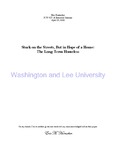Stuck on the Streets, But in Hope of a Home: The Long-Term Homeless

View/
Author
Hamscher, Eric
Subject
Washington and Lee University, Shepherd Poverty Program
Homelessness
Poverty
Mentally ill
Substance abuse
Housing
Economic assistance, Domestic
Metadata
Show full item recordDescription
Capstone; [FULL-TEXT FREELY AVAILABLE ONLINE] Eric M. Hamscher is a member of the Class of 2011 of Washington and Lee University. One of the most extreme forms of modern-day poverty in the United States, homelessness has been steadily increasing in urban prevalence since the 1970's.1 Although many people admit that homelessness is a problem in many of America's most prominent cities, fewer are willing to commit the time, money, and effort that would be necessary to address the problem and get people off the streets. This lack of attention is particularly disconcerting because homelessness is a complex problem in need of a multi-faceted solution. In order to create policies that are likely to be successful, the most significant causes and impacts of long-term homelessness in urban adult populations will be thoroughly examined. For this paper, long-term homelessness is defined as homelessness that is greater than one year in duration, and urban adult populations designate those groups of homeless individuals between the ages of 35 and 55 living in cities. This type of carefully defined target population increases the likelihood that new policies will have a positive impact on the long-term homeless. Although long-term homelessness occurs for a variety of reasons, the most significant causes for the defined population are substance abuse, chronic mental illness, and inadequate social services. Given these causes, the most practical and advantageous policy options to alleviate and diminish long-term homelessness in urban adult populations are the following: increased funding for construction of different low-income housing facilities, expansion of rehabilitation and mental health treatment centers, and improved accessibility to current social services. [From introductory section] Eric Hamscher